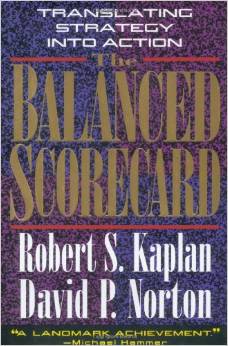From Publishers Weekly
As running a corporate?or government or not-for-profit?enterprise becomes increasingly complicated, more sophisticated approaches are needed to implement strategy and measure performance. Purely financial evaluations of performance, for example, no longer suffice in a world where intangible assets?relationships and capabilities?increasingly determine the prospects for success. Kaplan, a Harvard Business School professor of accounting, and Norton, president of Renaissance Solutions, make a key contribution by describing and illustrating the balanced scorecard, a multidimensional approach to measuring corporate performance that incorporates both financial and non-financial factors. The concept of a balanced scorecard originated in a study group of 12 companies that met throughout 1990; since then, the authors have worked with several companies, including FMC Corporation, Brown & Root Energy Services, Mobil and CIGNA, to create scorecards and use them as a systematic means to implement new organizational strategy. Though still in the preliminary stages of development, balanced scorecards could represent the emergence of a new era of management sophistication, in which both the hard and soft variables of work life are taken into account in a rigorous, testable fashion. Kaplan and Norton provide an excellent, though dry, introduction to a new methodology of management.
Copyright 1996 Reed Business Information, Inc.
From Library Journal
Kaplan (accounting, Harvard) and Norton, president of Renaissance Solutions Inc., created the “balanced scorecard” to assist businesses in moving from ideas to action, achieving long-term goals, and obtaining feedback about strategy. The balanced scorecard consists of four sections: clarifying and translating vision and strategy; communicating and linking strategic objectives and measures; planning, setting targets, and aligning strategic initiatives; and enhancing strategic feedback and learning. Because the writing is technically oriented and somewhat detailed, this work is geared toward scholars and high-level business planners. However, its clear organization makes reading and understanding the concepts much easier. Recommended for upper-level and graduate business students and senior practitioners in the strategic-planning field.?Randy Abbott, Univ. of Evansville Libs., Ind.
Copyright 1996 Reed Business Information, Inc.
Here is an accounting text that requires absolutely no knowledge of methods and acronyms, but rather needs a strong business orientation to understand. What professor Kaplan and consultant Norton have created is a system that not only measures but, more important, manages such elusive corporate goals as mission, vision, customer and employee satisfaction, and the like. The “balanced scorecard” they’ve devised is based on long-term studies of five companies. The beauty of the scorecard is its reality-grounded perspective; the authors readily admit, for instance, that if such a system is put into effect, it will fail without the consensus of senior management. For organizations and their employees undergoing change.
Barbara Jacobs
From the Back Cover
Here is the book – by the recognized architects of the Balanced Scorecard – that shows how managers can use this revolutionary tool to mobilize their people to fulfill the company’s mission. More than just a measurement system, the Balanced Scorecard is a management system that can channel the energies, abilities, and specific knowledge held by people throughout the organization toward achieving long-term strategic goals. Kaplan and Norton demonstrate how senior executives in industries such as banking, oil, insurance, and retailing are using the Balanced Scorecard both to guide current performance and to target future performance. They show how to use measures in four categories – financial performance, customer knowledge, internal business processes, and learning and growth – to align individual, organizational, and cross-departmental initiatives and to identify entirely new processes for meeting customer and shareholder objectives. The authors also reveal how to use the Balanced Scorecard as a robust learning system for testing, gaining feedback on, and updating the organization’s strategy. Finally, they walk through the steps that managers in any company can use to build their own Balanced Scorecard. The Balanced Scorecard provides the management system for companies to invest in the long term – in customers, in employees, in new product development, and in systems – rather than managing the bottom line to pump up short-term earnings. It will change the way you measure and manage your business.
About the Author
Robert Steven Kaplan is Senior Associate Dean and the Martin Marshall Professor of Management Practice in Business Administration at Harvard Business School. He is also cochairman of the Draper Richards Kaplan Foundation, a global venture philanthropy firm, as well as chairman and a founding partner of Indaba Capital Management, LLC. Before joining Harvard in 2005, Kaplan was vice chairman of the Goldman Sachs Group.
Norton is president of Renissance Solutions, Inc., and international consulting firm specializing i n performance measurement and organization renewal.
Norton is president of Renissance Solutions, Inc., and international consulting firm specializing i n performance measurement and organization renewal.
Robert Steven Kaplan is Senior Associate Dean and the Martin Marshall Professor of Management Practice in Business Administration at Harvard Business School. He is also cochairman of the Draper Richards Kaplan Foundation, a global venture philanthropy firm, as well as chairman and a founding partner of Indaba Capital Management, LLC. Before joining Harvard in 2005, Kaplan was vice chairman of the Goldman Sachs Group.



